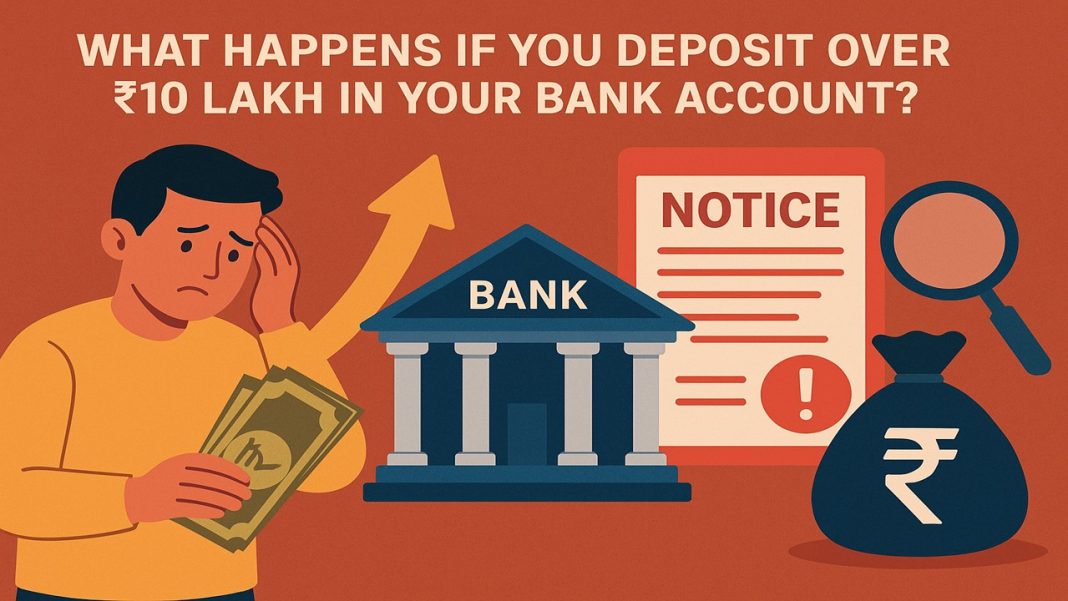Red Flags of Bank Deposits that Can Invite Income Tax Notice
If you put a large amount of money, like Rs. 15 lakh, into your savings account, the bank reports it to the Income Tax Department because it’s above a certain limit (usually Rs. 10 lakh in a year).
According to Balwant Jain, a Mumbai-based tax and investment expert, receiving a notice from the income tax department is possible if you make large or unexplained cash deposits. He added, “If the department issues a notice under Section 68, you will need to provide proper documentation like business records, gift deeds or sale proofs to explain the source of the funds.”
If you deposit more than Rs. 50,000 in cash in one day in your bank, you must give your PAN number.
If you deposit Rs. 10 lakh or more in your account (in cash or otherwise), the Income Tax Department may ask where the money came from (through notices under certain sections like 148 or 133(6)).
As per Section 269ST, you can’t receive Rs. 2 lakh or more in cash from a person in a single day, for a single transaction, or for one event. Payments above this must be made by bank transfer, cheque, or other non-cash methods.
Methods Of Tracking Large Transactions
The income tax department keeps a close eye on large transactions through the following methods:
- Statement of Financial Transactions (SFT)
- Annual information Return (AIR)
- Tax Deducted at Source (TDS)
- Tax Collected at Source (TCS)
- Income Tax Return (ITR) filings
What To do if You Receive Notice?
If you get an income tax notice under Section 68, it means the tax department wants to know where your cash or money came from. You’ll have to prove the source of that money. For example, you can show documents like business sales records, gift deeds, inheritance papers, or proof of withdrawal from another bank account to explain that the money is genuine and not unexplained income.
In case you fail to justify the sources, your funds could be considered as unexplained income and you will face high tax rates.
The income is taxed at 60% plus penalties, according to Balwant Jain.
How to Avoid Penalties
To avoid penalties, you must know the following important points:
- Keep your records of all large transactions, such as deposits and withdrawals.
- Ensure your funds come from legitimate sources such as documented business income, gifts or savings.
Tax Rules on Cash Deposits
Section 68 (Cash Credits)
You should justify the exact source of the cash, including business sales, withdrawals from other bank accounts, documented gifts or previously taxed income.
Section 69A (Unexplained Money)
If the Income Tax Department finds that you have deposited a large amount of cash, you must clearly explain where the money came from.
If you cannot give a proper or believable explanation, the department may treat the money as undisclosed income. This can lead to heavy tax, penalties, and even legal action.
The unexplained income is taxed at a flat 60%, along with applicable surcharges and cess. According to the income tax department, “Such a tax rate of 60% will be further increased by a 25% surcharge and a 6% penalty, i.e., the final tax rate comes out to be 84% (including cess). Provided that such a 6% penalty will not be levied when the income under Section 68, 69 etc., has been included in the return of income and tax has been paid on or before the end of the relevant previous year.”
You can’t use the basic tax-free limit, claim any deductions, or adjust losses against unexplained income. The full unexplained amount will be taxed with a penalty.
If you deposit Rs. 20 lakh in your savings account, it doesn’t automatically mean you’ll get a tax notice. But if you can’t clearly explain where the money came from, the Income Tax Department may check it. So, always keep proper proof and be transparent to avoid trouble.



